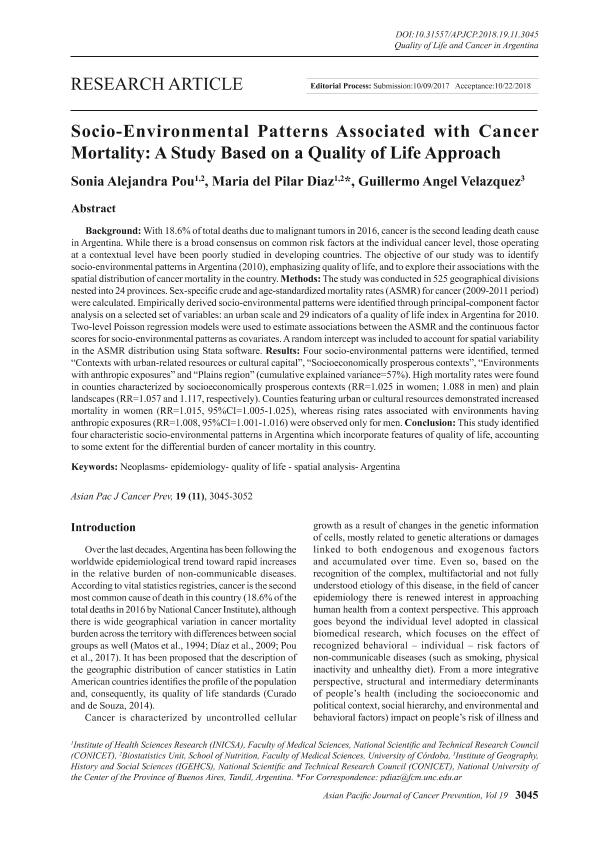Artículo
Socio-environmental patterns associated with cancer mortality: A study based on a quality of life approach
Fecha de publicación:
11/2018
Editorial:
Asian Pacific Organization Cancer Prevention
Revista:
Asian Pacific Journal of Cancer Prevention
ISSN:
1513-7368
Idioma:
Inglés
Tipo de recurso:
Artículo publicado
Clasificación temática:
Resumen
Background: With 18.6% of total deaths due to malignant tumors in 2016, cancer is the second leading death cause in Argentina. While there is a broad consensus on common risk factors at the individual cancer level, those operating at a contextual level have been poorly studied in developing countries. The objective of our study was to identify socio-environmental patterns in Argentina (2010), emphasizing quality of life, and to explore their associations with the spatial distribution of cancer mortality in the country. Methods: The study was conducted in 525 geographical divisions nested into 24 provinces. Sex-specific crude and age-standardized mortality rates (ASMR) for cancer (2009-2011 period) were calculated. Empirically derived socio-environmental patterns were identified through principal-component factor analysis on a selected set of variables: an urban scale and 29 indicators of a quality of life index in Argentina for 2010. Two-level Poisson regression models were used to estimate associations between the ASMR and the continuous factor scores for socio-environmental patterns as covariates. A random intercept was included to account for spatial variability in the ASMR distribution using Stata software. Results: Four socio-environmental patterns were identified, termed "Contexts with urban-related resources or cultural capital", "Socioeconomically prosperous contexts", "Environments with anthropic exposures" and "Plains region" (cumulative explained variance=57%). High mortality rates were found in counties characterized by socioeconomically prosperous contexts (RR=1.025 in women; 1.088 in men) and plain landscapes (RR=1.057 and 1.117, respectively). Counties featuring urban or cultural resources demonstrated increased mortality in women (RR=1.015, 95%CI=1.005-1.025), whereas rising rates associated with environments having anthropic exposures (RR=1.008, 95%CI=1.001-1.016) were observed only for men. Conclusion: This study identified four characteristic socio-environmental patterns in Argentina which incorporate features of quality of life, accounting to some extent for the differential burden of cancer mortality in this country.
Palabras clave:
Argentina
,
Epidemiology
,
Neoplasms
,
Quality of Life
,
Spatial Analysis
Archivos asociados
Licencia
Identificadores
Colecciones
Articulos(IGEHCS)
Articulos de INSTITUTO DE GEOGRAFIA, HISTORIA Y CS. SOCIALES
Articulos de INSTITUTO DE GEOGRAFIA, HISTORIA Y CS. SOCIALES
Citación
Pou, Sonia Alejandra; Diaz, Maria del Pilar; Velázquez, Guillermo Ángel; Socio-environmental patterns associated with cancer mortality: A study based on a quality of life approach; Asian Pacific Organization Cancer Prevention; Asian Pacific Journal of Cancer Prevention; 19; 11; 11-2018; 3045-3052
Compartir
Altmétricas




